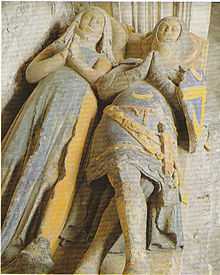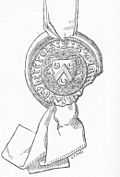Coity Castle

Coity Castle in Glamorgan, Wales is a Norman castle built by Sir Payn "the Demon" de Turberville (fl. 1126), one of the legendary Twelve Knights of Glamorgan supposed to have conquered Glamorgan under the leadership of Robert FitzHamon (d.1107), Lord of Gloucester. Now in ruins, it stands in the Community of Coity Higher near the town of Bridgend, in the County Borough of Bridgend. Very close to the castle is the battlemented parish church of St Mary the Virgin, dating from the 14th century.
Castle Construction and Modification


The castle began as a late 11th century ringwork. A rectangular stone keep and the main curtain wall were added by the Normans in the 12th century, under the de Turberville family. The three-storey keep was primarily a defensive structure.[2]
Extensive reworking took place in the 14th century, when a domestic range was attached to the keep by the middle gatehouse. New stone vaults replaced the earlier timber floors. The central octagonal pier for the vaults is still prominent among the castle ruins. An adjoining chapel wing with a tall east window was added to the first floor at the eastern end of the domestic range in the 15th century.
During the 16th century Coity Castle, by then owned by the Gamage family, underwent a complete remodelling of the living quarters, including the addition of a storey, new windows and two chimney stacks. The principal chambers lay on the upper floors. The range of domestic apartments comprised a central first-floor hall set above a vaulted undercroft, from which it was reached by a grand spiral stair. To the west were ground-floor service rooms, probably including a kitchen, with ovens. The base of a ruined large malting kiln remains. On the far side of the range, a tower projecting from the curtain wall contained latrines. The second floor housed private apartments.[3]
The Lordship of Coity
Turberville

The de Turberville family held the Lordship of Coity from c. 1092 to 1360, which had been founded by Sir Payn de Turberville, one of the legendary Twelve Knights of Glamorgan of Robert FitzHamon, 1st. Lord of Glamorgan. Richard de Turberville, seemingly his 6th great grandson, died in 1384 without male heir, leaving his four sisters as co-heiresses:
- Katherine de Turberville, the eldest, had married Sir Roger Berkerolles (d.1351), another descendant of one of the Twelve Knights of Glamorgan, of East Orchard, St Athan. The tomb effigies of Katherine and Sir Roger can be seen in St Athan's Church. Their son was Sir Lawrence Berkerolles (d.1411), the last of the Berkerolles, who died without progeny.
- Margaret de Turberville, the second daughter, married Sir Richard Stackpole, whose daughter Joan Stackpole married Sir Richard Verney.
- Agnes de Turberville, the third daughter, married Sir John de la Bere of Weobly Castle, Gower.
- Sarah de Turberville, the fourth and youngest, married William Gamage of Rogiet.
Berkerolles


It was Sir Lawrence Berkerolles (d.1411), son of Katherine the eldest daughter, who succeeded to Coity. His sister Wenllian Berkerolles had married Sir Edward Stradling of nearby St. Donat's Castle. Under his tenure Coity Castle resisted an attack by the forces of Owain Glyndŵr (Owen Glendower) and a long siege followed lasting into 1405. King Henry IV was petitioned by Parliament to send a relief force and he dispatched three Bristol sea captains to resupply the besieged garrison. The Berkerolles' tenure of Coiety ended on 18 October 1411, on the death of Sir Lawrence sine prole.
De la Bere
The heir of Sir Lawrence Berkerolles was his 1st. cousin once removed, the minor Thomas de la Bere, the son of John de la Bere deceased, son of Agnes Turberville (3rd. sister of Richard) and Sir John de la Bere. Margaret de Turberville the 2nd. sister appears to have produced no male progeny, only a daughter, Johanna, Lady Vernon. During the minority of Thomas, Coity briefly escheated to the King, under the hand Isabel Despenser, seemingly in her capacity as Lord of Glamorgan, she being the wife of Richard de Beauchamp, Lord of Bergavenny,[5]
Gamage

Thomas de la Bere died as a minor on 28 October 1414, following which the lordship reverted to Sarah de Turberville, the youngest sister of Richard de Turberville, who had apparently produced male progeny from her marriage to William Gamage. There was in the few years following Sir Lawrence Berkerolles's death much general re-shuffling of property interests in Glamorgan, for example with the Stradling family. Sarah's marriage to Sir William Gamage of Roggiett, Gwent brought the lordship into the Gamage family, where it remained until 1584. The Gamage succession was not however easily achieved for in September 1412, that is to say whilst the supposed true heir the minor Thomas de la Bere was still alive, William Gamage assisted by Sir Gilbert Denys(d.1422) of Siston, Gloucestershire and formerly of Waterton-by-Ewenny,[6] in Coity lordship, besieged Coity for a month, trying to oust Lady Joan Verney, wife of Sir Richard Verney and daughter of Margaret de Turberville, from the Castle. Joan it seems had taken up residence to assert her own claim to Coity in the confusion following Berkerolles's death. As she was a female, a widower and without a son, clearly her claim was deemed tenuous or rather completely spurious. The entry in the Patent Rolls is as follows:
Westminster Sept. 16, 1412. Commission to William Newport, Chivaler, Rees ap Thomas, John Organ, William Sparenore, Richard Delabere and Robert Wytney on information that Gilbert Denys, Chivaler, and William Gamedge, with no moderate multitude of armed men have gone to the castle of Coytif in Wales and besiege it and purpose to expel Joan, late the wife of Richard Vernon, Chivaler, from her possession of it, to go as quietly as they can to the castle and raise the siege, cause proclamation to be made that no one under pain of forfeiture shall besiege it, but those who pretend right and title in it shall sue according to law and custom. Arrest and imprison all who oppose them and certify thereon to the King in Chancery. By K.
The king had therefore given a commission to his local tenants-in-chief to raise the siege and gave another commission a month later to John Grendour for the same purpose.[7] Denys and Gamage ended up in the Tower of London for having taken the law into their own hands, from 19th. November 1412 until 3rd. June 1413, being released after the death of Henry IV.[8] Their action however proved successful in enforcing the Gamage claim to Coity. Denys's eldest daughter Joan was the wife of a certain Thomas Gamage,[9] possibly brother of William. Another of Denys's daughters, Matilda, by his 2nd. wife, married another Thomas Gamage, son or grandson of William and Sarah, and thereby became Lady of Coity on her husband's succession, producing a son & heir John Gamage.[10]
Sidney
The Gamage family held Coity until the death of John Gamage in 1584.[11] His sole heiress Barbara Gamage had married Robert Sidney, 1st Earl of Leicester and thus Coity passed to the Sidney family, whose chief seat was Penshurst Place in Kent, which held it until the 18th. century. Barbara died at Coity in 1621.
Edwin , Earls of Dunreven
The lordship was sold in the 18th. c. to the Edwins of Llanharry. Through the Edwins, the Coity lordship passed to the Earls of Dunraven.[12]
Decline
The castle was abandoned around the 17th century and the castle ruins are now in the care of Cadw.
See also
- List of castles in Wales
- List of Scheduled Monuments in Bridgend
- List of Cadw properties
- Castles in Great Britain and Ireland
References and sources
- References
- ↑ These were the arms of the heiress Barbara Gammage borne as an escutcheon of pretence by her husband Robert Sidney, 1st Earl of Leicester, as is visible on the imprints of 55 books donated by him to the Bodleian Library. The earlier arms of Gammage found on various rolls of arms omitted the escallops and place the bend fusilly over all
- ↑ Cadw informational sign posted at Coity Castle
- ↑ Cadw informational sign posted at Coity Castle
- ↑ Crescents sometimes given as argent
- ↑ Cal. of Fine Rolls, 1413-1422 (1934): 100, 441/442. Entry dated 16/1/1415, includes a long list of the tenants holding under Berkerolles, "lands held of Isabel wife of Richard de Bello Campo of Bergavenny, chivaler, as to the lordship of Kerdyf and the co. of Glamorgan by service of a moiety of a knight's fee..."
- ↑ Denys was probably the son of John Denys of Waterton mentioned in Clark's Cartae no. MXLIII, 1376, Who was granted a lease by Margam Abbey. Sir Gilbert Denys is mentioned as renting property at Waterton from Sir Roger Berkerolles in the latter's Inq.p.m.
- ↑ Patent Rolls, 12 Oct 1412, at Westminster.
- ↑ Roskell, J.S. History of Parliament: House of Commons 1386-1421 (vol.2) 1992, p772. Biog. of Sir Gilbert Denys.
- ↑ See the will of Sir Gilbert Denys in which he names his da. Joan "wife of Thomas Gamage" as his executrix. Line 12: "Ordino et confirmo Johnam filiam meam uxorem Thom. Gamage..."National Archives, PROB 11/2B Image Ref:413/285.
- ↑ Dictionary of Welsh Biography, National Library of Wales. Welsh Biography Online. (Gamage)
- ↑ Griffiths, Royston; William John Morgan, Vaughan Richards (2007). A History of the Parish Church of St. Mary the Virgin. Parish Church of St. Mary the Virgin, Coity.
- ↑ Griffiths, Royston; William John Morgan, Vaughan Richards (2007). A History of the Parish Church of St. Mary the Virgin. Parish Church of St. Mary the Virgin, Coity.
- Sources
- The Welsh Academy Encyclopaedia of Wales. John Davies, Nigel Jenkins, Menna Baines and Peredur Lynch (2008) pg160 ISBN 978-0-7083-1953-6
External links
![]() Media related to Coity Castle at Wikimedia Commons
Media related to Coity Castle at Wikimedia Commons
| |||||||||||||||||||||||
Coordinates: 51°31′19″N 3°33′11″W / 51.52194°N 3.55306°W
